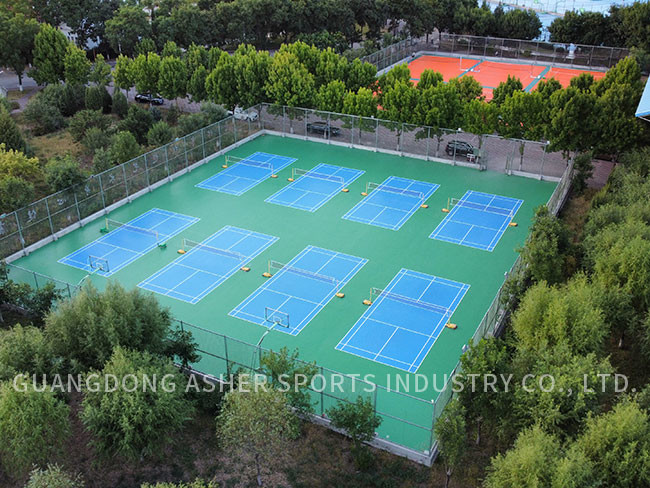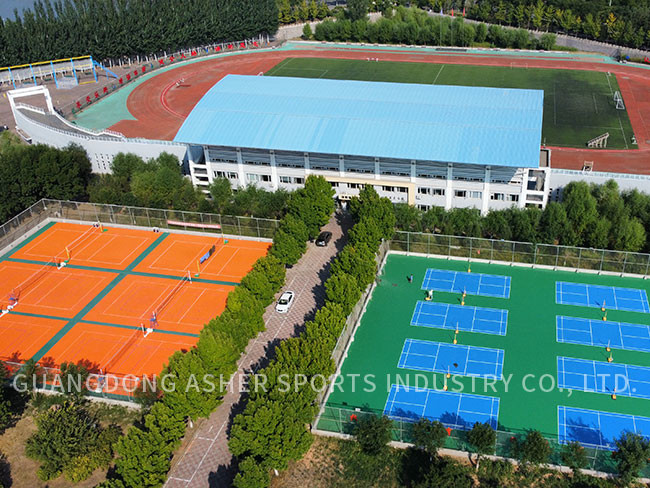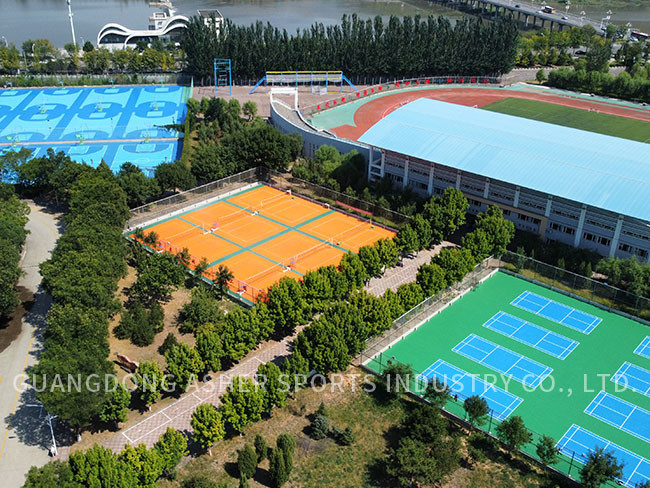Guangdong Asher Sports Industry Co., Ltd. |
|
Verified Suppliers
|
|
SPU Basketball Court Flooring, 3-8mm Thickness, 22% Force Reduction
Product Name | SPU surface sport flooring | |||
Thickness | 3mm, 4mm, 5mm, 6mm, 7mm, 8mm | |||
Force Reduction | 22% | |||
Tensile Strength | 0.88 N/mm2 | |||
Elongation at Break | 61% | |||
Ball Rebound | 99% | |||
Taber Abrasion | 0.31 gr | |||
Thermoplastic polyurethane elastomer rubber
Product characteristics:
(1) Has good weather resistance and UV resistance;
(2) Has superior weather resistance, strong wear resistance, and excellent stain resistance;
(3) Low compression deformation rate and good elasticity;
(4) Suitable for concrete and asphalt foundations.
Introduction to water-based silicon PU surface layer
The internationally recognized match court is made of Thermoplastic polyurethane elastomer rubber, which does not contain any waste filler, so it can ensure the environmental protection and stability of the product and has good resistance;
Its good elastic performance can reduce the damage caused by ground reaction forces on athletes' ankles, joints, and ligaments;
It is suitable for indoor Basketball court, tennis court, volleyball court, badminton court and other professional competition venues.
Requirements for the ground of the competition venue
1. The ground of the site must be flat, level, and free from sinking cracks.
2. The ground of the venue must not have any potential hazards that could harm team members.
3. Do not compete on rough, wet, or slippery surfaces.
4. The ground of the FIBA World Championship venue can only be made of wood or synthetic materials.
5. If it is an indoor venue, the net height of tennis and volleyball should not be less than 12 meters.
Construction of water-based silicon PU material
1. Pickling:
Wet the foundation with clean water (to prevent dilute hydrochloric acid from seeping into the foundation), evenly sprinkle and wash the foundation surface with a concentration of about 8% dilute hydrochloric acid, and then rinse it with clean water (usually twice);
After washing and drying, it is required that the base cement is in its original color, free from white powdery substances and loose matter. During the acid washing process, the accumulated water level should be circled and marked.
2. Primer:
Wet the foundation with clean water (to prevent dilute hydrochloric
acid from seeping into the foundation), evenly sprinkle and wash
the foundation surface with a concentration of about 8% dilute
hydrochloric acid, and then rinse it with clean water (usually
twice);
After washing and drying, it is required that the base cement is in
its original color, free from white powdery substances and loose
matter. During the acid washing process, the accumulated water
level should be circled and marked.
After the foundation is sufficiently dry, use a special primer to roll coat it on the base surface. The principle is to form a bright film on the base surface after brushing, and the insufficient areas must be repainted until sufficient. The purpose of the primer is to penetrate into the micro pores of the foundation, block underground water vapor and reinforce the base surface after solidification;
The formation of a bright film is to ensure that the micro pores of the foundation are completely blocked. Construction should be avoided in scorching sunlight or at high foundation temperatures (>450C) to ensure the permeability of the primer (morning or evening without fog or rain is more suitable).
When the strength of the foundation surface is less than C20 or the surface is relatively loose, the elastic layer can be diluted with one time the diluent and then thick coated on the base surface (to enhance its permeability and increase the penetration depth of the buffer layer) until a bright film is formed on the surface, so that the foundation surface can meet the construction requirements.
3. Elastic layer:
Before the construction of the elastic layer, it is necessary to carefully check and confirm that the foundation treatment is completed before proceeding with the construction of the elastic layer. The elastic layer is a single component material, and diluent and water are needed to adjust the appropriate construction consistency. (The diluent dosage is 1KG per bucket, and the water dosage is one cup per bucket) Use a scraper to apply it to the base surface;
The thickness of each coating should not exceed 1.5mm, and the interval between each coating should be based on the previous dry curing (usually about 8 hours, depending on the weather conditions on site) until the required thickness is achieved.
When applying, pay attention to the leveling effect. If it cannot be leveled, add more diluent to ensure the surface is leveled. If the temperature is low (<10 ℃) and the relative humidity is low (<60%), it is necessary to add (3-8%) water and stir evenly before scraping to accelerate material solidification and reduce interval time. The specific amount of water added depends on the weather on site, and construction should be avoided under strong sunlight;
After the elastic layer is dried and solidified, the surface flatness is tested using the water accumulation method. The water accumulation area is repaired and leveled with the elastic layer. If there are granular debris or accumulated areas on the surface, a grinder or other tools need to be used to flatten them before carrying out the reinforcement layer construction.
4. Strengthening layer:
The strengthening layer is a single component material, and the construction method is the same as the elastic layer. If there are impurities mixed in or uneven areas scratched during the construction process, the surface layer construction can only be carried out after smoothing.
5. Surface layer:
The surface layer is a two component water-based material, and the two components must be thoroughly mixed according to the specified ratio (A: B=1:19 by weight). Then, quartz sand (3% of the total amount of mixed topcoat) and an appropriate amount of water must be added, and the material must be thoroughly mixed before using a roller for construction.
6. Scribing:
Measure and position according to the standard size, mark the position of the boundary, stick it on the court along both sides of the boundary with masking paper, apply special water-based marking paint between the masking paper, and tear off the masking paper after the surface is dry. The water-based marking paint is a two component material, and components A and B must be thoroughly mixed and evenly applied to the surface according to the specified ratio.
Construction requirements for stadium surface layer
Basic requirements
(1) Cement foundation requirements: no honeycomb, pitted surface, exposed stones, exposed reinforcement, cracks, foundation settlement, etc. Asphalt foundation requirements: The asphalt layer is 5 centimeters thick, and the foundation surface is free from fractures, grinding marks, honeycomb or peeling.
(2) Flatness requirements: The positive and negative error of a 4M ruler is ≤ 5MM, the maintenance period is 28 days, and the foundation surface is free of oil, ash, and dry.
Stadium Standard Specifications
(1) Boundary color: white.
(2) Court color: Different colors are required for the court area and buffer area, with green for the regular home court and red for the secondary court.
(3) The courts are divided into indoor and outdoor types, and indoor courts can be shared with volleyball courts.
(4) Outdoor venues generally require a north-south orientation of the long axis.
Stadium size specifications
1. The size within the main functional line (excluding the functional line) is a standard fixed size;
2. The overall size of the site can be adjusted ± according to the actual situation on site;
3. If the site size is limited, separate drawings can be provided according to the actual situation.
Completion acceptance
(1) After the completion of the pavement construction of the water-based silicon PU stadium surface, draw the completion drawing.
(2) Organize construction operation records and write a construction summary.
(3) Conduct a comprehensive acceptance of the water-based silicon PU project together with Party A, and promptly rectify the specific issues
raised during the acceptance based on the principle of "user first" to ensure user satisfaction and provide after-sales service.


